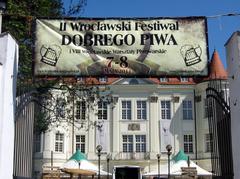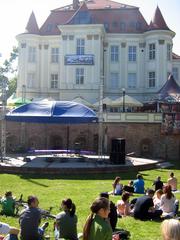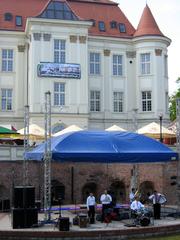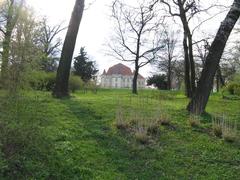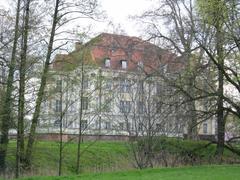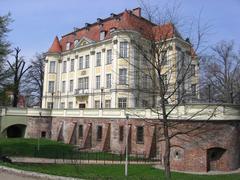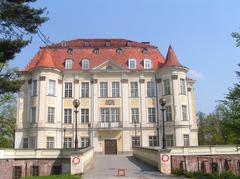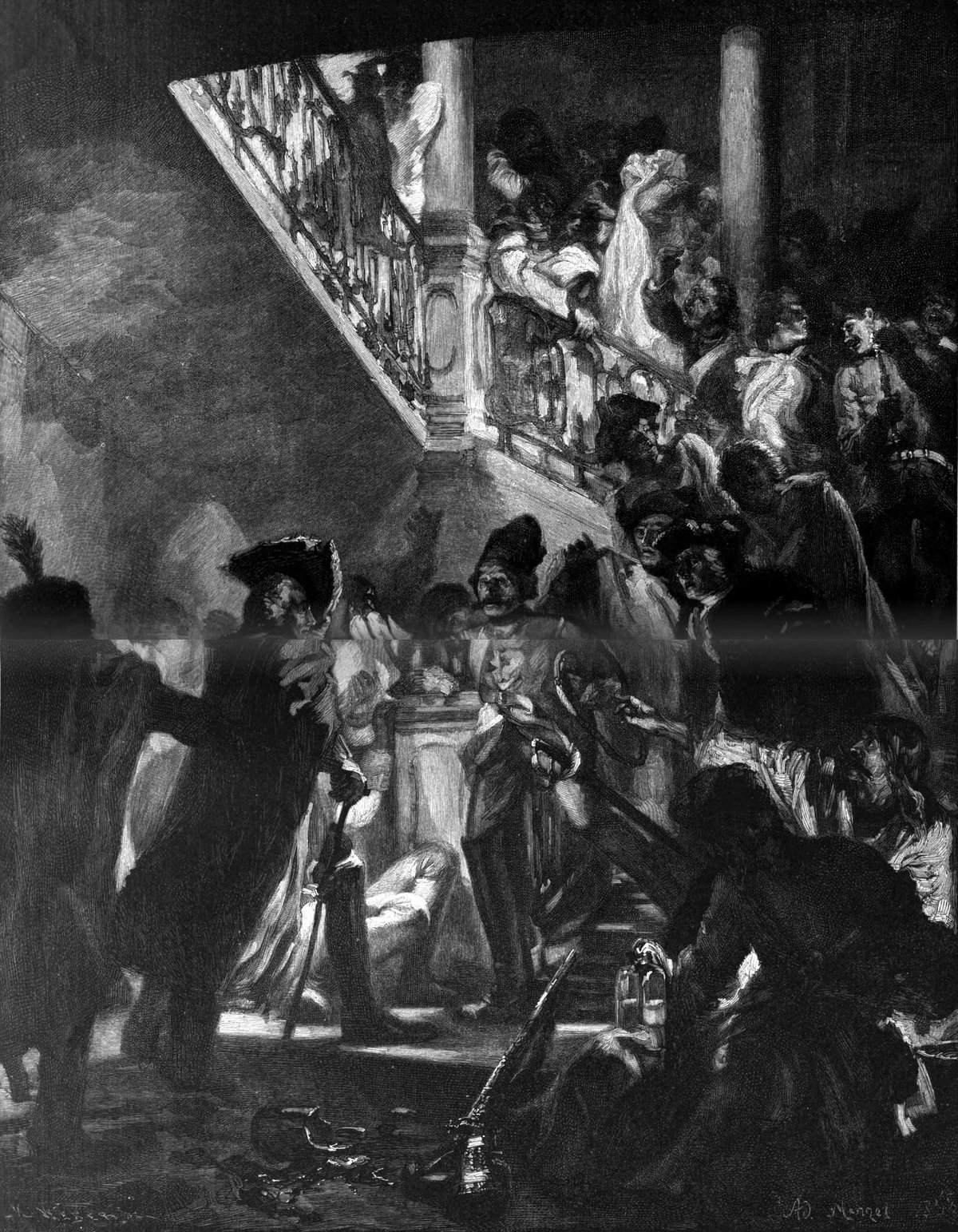
Leśnica Castle: Visiting Hours, Tickets, and Historical Sites Guide — Wrocław, Poland
Date: 14/06/2025
Introduction
Leśnica Castle, located in the leafy Leśnica district of Wrocław, Poland, is an enduring symbol of Silesian heritage and architectural transformation. Originally built as a Piast dynasty stronghold in the 12th century, the castle has witnessed the shifting tides of Central European history — from medieval warfare and dynastic change to Baroque renewal and contemporary cultural revival. Today, Leśnica Castle not only preserves its layered past through its architecture and cellars but also serves as a vibrant cultural hub, hosting exhibitions, events, and educational activities. This comprehensive guide presents everything you need to plan your visit, including historical context, visitor information, ticketing, accessibility, and nearby attractions (pl.wikipedia.org, its-poland.com, WroclawGuide, zamek.wroclaw.pl).
Table of Contents
- Historical Overview
- Architectural Features
- Visitor Information and Tickets
- Accessibility
- Travel Tips & Getting There
- Cultural Significance
- Guided Tours & Events
- Nearby Attractions
- FAQs
- Visitor Experience
- Conclusion & Final Tips
- References
Historical Overview
Early Origins and Piast Dynasty Era (12th–14th Centuries)
Leśnica Castle’s roots trace back to 1132, established as a fortified residence for the Piast dynasty (pl.wikipedia.org). This early fortification played a vital role in Silesia’s medieval power dynamics, serving as both a ducal seat and administrative center. Notably, Duke Bolesław I the Tall died here in 1201, and his successors maintained Leśnica as a strategic residence due to its location on the route between Wrocław and Legnica.
In 1271, documentary evidence confirms the presence of a stone castle, marking the transition from wooden fort to more permanent architecture. The Piasts’ tenure ended in 1335 with the death of Henry VI the Good, after which the duchy, including Leśnica, passed to the Kingdom of Bohemia.
Bohemian and Patrician Ownership (14th–15th Centuries)
In 1339, King John of Bohemia sold the castle to Gysko de Reste, a Wrocław burgher, initiating a period of patrician ownership (pl.wikipedia.org). The castle passed through several prominent families and underwent fortification enhancements, reflecting its continued strategic importance. In 1420, a new fortified residence surrounded by a moat was constructed, and the castle hosted Emperor Charles IV in 1348.
Renaissance and Baroque Transformations (15th–19th Centuries)
The Hussite Wars brought devastation in 1428, and the castle was repeatedly rebuilt and modernized. By the 16th century, Renaissance elements were introduced alongside military fortifications. In the Baroque period (1735–1740), architect Christoph Hackner transformed the castle into its current two-winged, three-story brick and plaster form, complete with bastion-like terraces and a landscaped park (its-poland.com). Ownership passed through various noble families, and after the Silesian Wars, Leśnica became part of Prussia and later Germany.
Modern Era and Restoration (20th–21st Centuries)
Leśnica Castle survived WWII with little damage but was gutted by fire in 1953. Reconstruction began in 1958, repurposing the castle as a cultural center. Listed as a historic monument in 1962, the castle has since been restored and modernized while preserving its historical layers (zamek.wroclaw.pl). Today, it is home to the “Zamek” Cultural Centre and plays an active role in Wrocław’s cultural landscape.
Architectural Features
Leśnica Castle is characterized by its two-winged, three-story layout in plastered brick, dry moat, and bastion fortifications now serving as terraces (Tropter). The medieval cellars are notable for their thick stone walls and vaulted ceilings, remnants from the 13th century. Baroque interiors, though largely reconstructed after the 1953 fire, retain elegant spatial arrangements.
Landscaped gardens and Leśnicki Park envelop the castle, offering tranquil settings for walks and cultural events (WroclawGuide).
Visitor Information and Tickets
-
Visiting Hours:
- Monday–Friday: 08:00–20:00
- Saturday–Sunday: 10:00–18:00
- Closed on select public holidays (UrTrips), zamek.wroclaw.pl
-
Ticket Prices:
- Adults: 20 PLN
- Seniors/Students: 10 PLN
- Children under 6: Free
- Discounts may apply; check the official website for details. Some cultural events and exhibitions are free (UrTrips).
-
Facilities:
- Restrooms and complimentary Wi-Fi in main building
- Café and gift shop (select times/events)
- Leaflets and some signage available in English
- Secure parking nearby (limited spaces; public transport encouraged)
Accessibility
- Wheelchair Access: The main entrance and ground floor are accessible; upper floors may require stair use. Ramps and adapted restrooms are provided.
- Assistance: Staff can assist visitors with special needs—contact in advance (Zamek Wroclaw).
- Family Friendly: Open spaces and occasional children’s workshops are available.
Travel Tips & Getting There
- Location: Plac Świętojański 1, 54-076 Wrocław, Poland
- Public Transport: Tram lines 3, 10, 20, and bus lines serve the Leśnica stop, just a short walk away (WroclawGuide).
- Car: Limited street parking nearby
- Cycling: Dedicated bike paths from city center
Cultural Significance
Leśnica Castle reflects nearly nine centuries of Silesian power, artistry, and resilience. It served as a princely residence, hosted monarchs and military leaders, and was shaped by noble families and religious orders (zamek.wroclaw.pl, szlakzamkowipalacow.eu). The castle’s layered architecture embodies medieval, Renaissance, and Baroque influences. Its adaptive reuse as a cultural center preserves its legacy and engages the community through art, music, and education.
Guided Tours & Events
- Guided Tours: Offered in Polish and occasionally in English. Booking in advance is recommended (UrTrips).
- Events: The “Zamek” Cultural Centre hosts exhibitions, concerts, workshops, and seasonal fairs. Check the official events calendar for schedules.
Nearby Attractions
- Leśnicki Park: A scenic park surrounding the castle, ideal for strolls and picnics.
- Stara Garbarnia Banquet Park: 850 meters from the castle, a popular spot for outdoor events (UrTrips).
- Leśnica District: Explore local cafes, churches, and historic town center.
- Wrocław Old Town: Accessible by tram; includes Market Square and Cathedral.
FAQs
Q: What are Leśnica Castle’s visiting hours?
A: Monday–Friday: 08:00–20:00; Saturday–Sunday: 10:00–18:00. Closed on some holidays.
Q: How much are tickets?
A: 20 PLN for adults, 10 PLN for seniors/students, free for children under 6.
Q: Is the castle wheelchair accessible?
A: The ground floor is accessible; upper floors may require stair use. Contact staff for assistance.
Q: Are guided tours available in English?
A: Occasionally; check the events calendar for current offerings.
Q: Are there free events?
A: Many cultural events are free; some exhibitions may require a ticket.
Q: Can I visit the gardens without a ticket?
A: Yes, the gardens are open to the public.
Visitor Experience
Highlights include:
- Exploring medieval cellars and Baroque halls
- Enjoying tranquil gardens and bastion terraces
- Participating in cultural events organized by the “Zamek” Cultural Centre
- Photographing historic architectural details and scenic park views
For a virtual preview, visit the official website’s photo galleries and virtual tours (zamek.wroclaw.pl).
Conclusion & Final Tips
Leśnica Castle is an unmissable destination blending history, architecture, and vibrant community life. Its evolution from a medieval fortress to a modern cultural center tells the story of Silesia’s resilience and creativity. Use public transport for easy access, consult the official website for current events and tickets, and allow time to enjoy both the castle and its surrounding park.
For curated experiences and updates, download the Audiala app and follow the castle on social media. Make Leśnica Castle a highlight of your Wrocław journey!
References
- Leśnica Castle — Wikipedia (pl)
- Leśnica Palace (Castle) — ITS Poland
- The 25 Most Impressive Buildings in Wrocław — WroclawGuide
- History of the Leśnica Castle — Zamek Wrocław
- Leśnica Castle in Wrocław — UrTrips
- Szlak Zamków i Pałaców — Leśnica Castle
- Leśnica Castle — Volunteering

